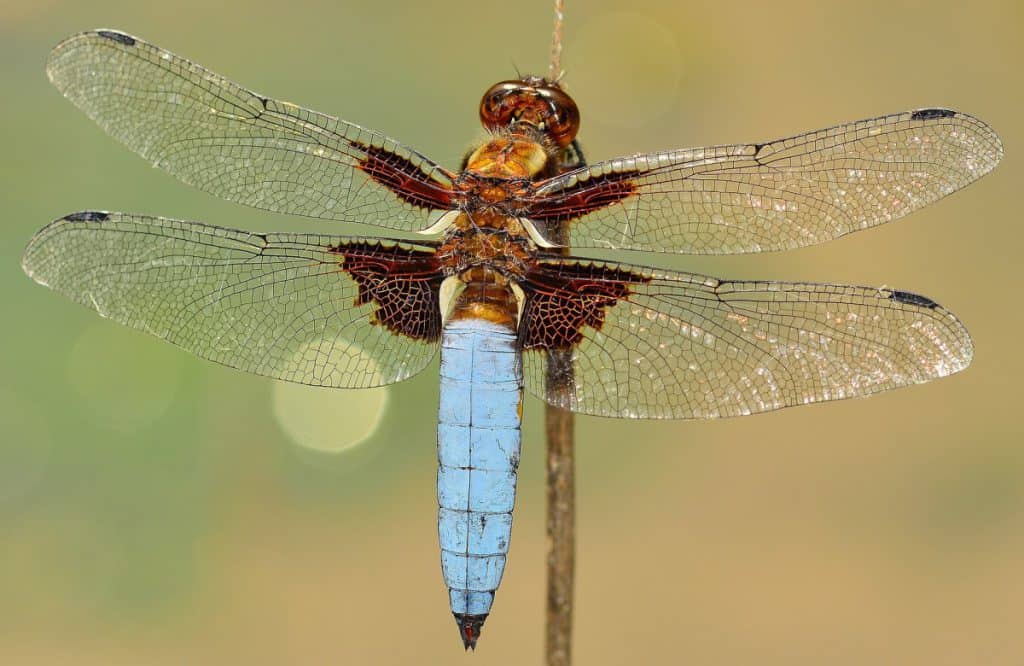
Dragonflies are to insects what hummingbirds are to birds – a lightning quick ephemeral presence often associated with a bright flash of color.
Dragonflies are ancient, the first ones evolved 300 million years ago. They used to be huge – up to a couple of feet in wing span – in the oxygen abundant Paleozoic era. Modern dragonflies are tiny, typically between two to five inches in wing span. And they can flit about like a helicopter, up, down, sideways, ahead and back. Often times, all you see is a flash of color.
These vibrant colors are not just aesthetic, they serve specific purposes. Certain colors are handy camouflage that help dragonflies blend into their surroundings and stay safe. But they could also be used to attract mates, or to warn off would-be predators. Dragonflies have sharp eyesight, so pairing up with mates often starts with spotting the right color.
There are two types of colors found on dragonflies:
- (a) natural pigmentation
- (b) structural colors.
The natural colors of an adult dragonfly are often a combination of red, brown, black or yellow colors pigments. On the other hand, dragonflies can show bright blue or green iridescence due to structural colors that are created by photonic cells that reflect certain bands of light in specific ways.
Natural pigmentation stays the same whenever or wherever you see it. But with structural colors, the angle at which light hits the surface will cause the color to change – a shimmering effect we call iridescence.
dragonflies and damselfliesare insects that belong to the order Odonata. There are likely more than 5,000 species of dragonflies in the world, out of which some 450 are found in the US.
Dragonflies Colors Often Vary by Age, Sex and Body Part
As we go on to discuss the gamut of colors found in dragonflies, it’s important to remember that most specimens exhibit more than one color. There are multiple reasons for this:
(a) Dragonflies frequently change color as they move from the larval stage to a nymph (or young adult) stage, to eventually an adult. For example, dragonfly nymphs usually blend in with shades of dull brown and grey. Their colors get brighter as they mature.
There are exceptions. For example, the young Western Pondhawk dragonflies are bright green in color, but they fade to ash grey when they grow older.
(b) Often time, males and female dragonflies will develop distinctly different colors. This helps them find mates as described above. Multiple examples are given below.
(c) Besides normal iridescence that causes them to change color as they flit about, dragonflies often sport different colors and markings on their bodies and wings. Brown patches or multi-colored veins or edges are common on dragonfly wings. A number of dragonfly species are characterized by shimmering colors of their large, compound eyes.
Bottom line, it is not always possible to classify dragonflies as being one consistent color. The descriptions below typically focus on the predominant color exhibited by the more colorful member of the species. Also, we have avoided including damselflies, who are closely aligned but a distinctly different species.
Can Dragonflies Be Red?
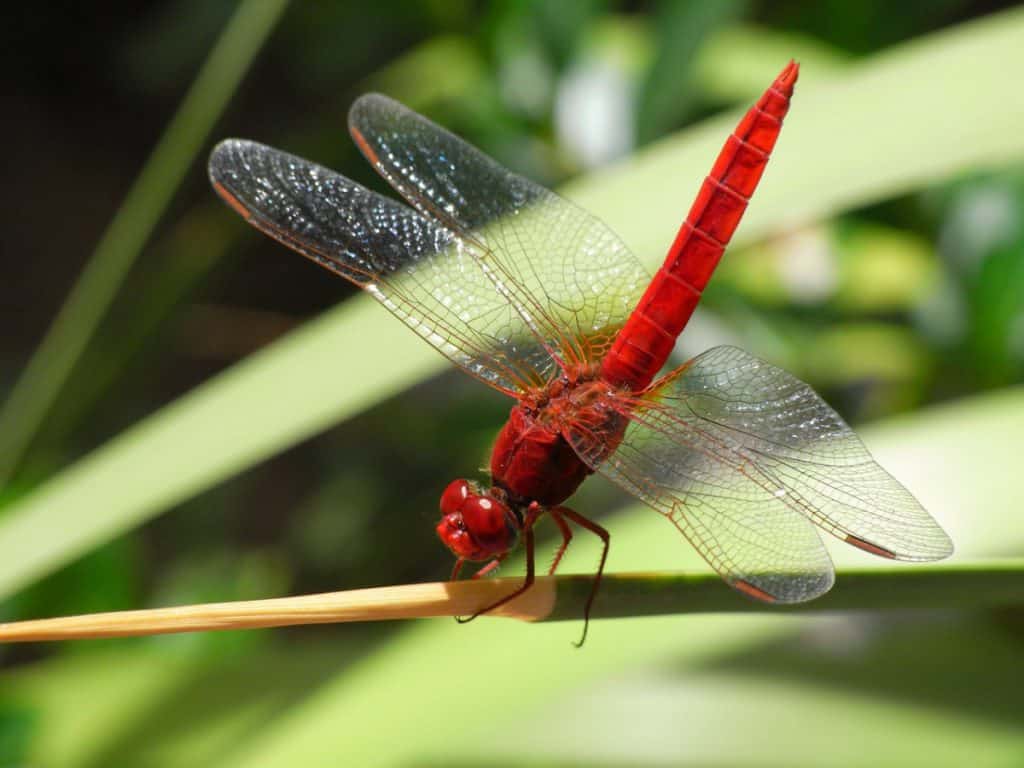
Red is a natural color that sometimes exists with black or other bases in dragonflies. Predominantly red dragonflies are striking. The Japanese consider them to be sacred, a symbol of a symbol of good fortune. Many Native American tribes believe that red dragonflies represent a time of rejuvenation after trials and tribulations.
a) Are Red Dragonflies Rare?
Red dragonflies are found all over the world, though they can be rare to view. One of the best-known specimens is the male Red-veined Darter or Nomad (Sympetrum Fonscolombli) found in Europe. Common red dragonflies in the US include the Needham’s Skimmer (Libellula needham), the Neon Skimmer (Libellula croceipennis), the Desert Firetail (Telebasis salva), the Carolina Saddlebags (Tramea Carolina), the Red Saddlebags (Tramea onusta), Ruby Meadowhawks (Sympetrum rubicundulum), the Saffron-winged Meadowhawk (Sympetrum costiferum) and the White-faced Meadowhawks (Sympetrum obtrusum).
b) How Do You Identify This Type of Dragonfly?
Most species of red dragonflies are easy to spot due to their striking color. The Red-veined Darter male is deep red in color, with red wing veins, whereas the female is ocher yellow. They can be distinguished by their blue eyes as well. The Neon Skimmer has a distinctive pink and red form. Male Needham’s Skimmers have a reddish-brown thorax and a deep red abdomen, with a thin black line on the tip of the dorsal surface.
The two Saddlebag species both have black tipped red abdomens, the Red Saddlebags have a red forehead and fewer red patches covering their hind wings. The White-Faced Meadowhawk grows into a strikingly red body but has a white head and face to distinguish it, otherwise the three Meadowhawk species are difficult to distinguish from each other.
c) Where Can They Be Found?
Red dragonflies can be found all over the world. The Red-veined Darter is native to Southern and Northwestern Europe, as well as the British Isles. The North American species mentioned above can be found all over the US.
Can Dragonflies Be Black?
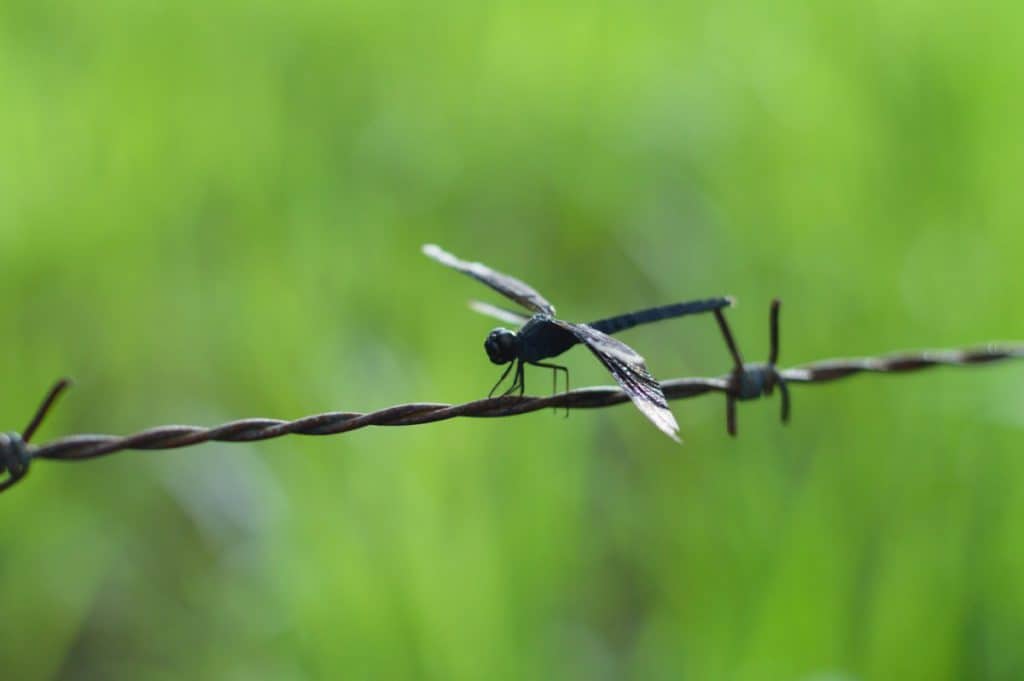
Dragonflies often show patches or bands of black on other backgrounds, alternating stripes of black and some other color or predominantly black backgrounds with other, iridescent colors.
a) Are Black Dragonflies Rare?
Black dragonflies are common. The largest dragonfly in the world, the Giant Petaltail (Petalura ingentisssima), found in North Eastern Australia, is black with yellow markings. The Black Saddlebag (Tramea lacerata), also known is the Jagged-edged Saddlebag, is common in North America. The Hudsonian Whiteface (Leucorrhinia hudsonica) is named after its natural habitat around the Hudson Bay. The Golden-ringed Dragonfly (Cordulegaster boltonii) is the longest British species of dragonfly.
b) How Do You Identify This Type of Dragonfly?
The Giant Petaltails, with wingspans that could exceed 6 inches and heavy black bodies with yellow markings, are easy to spot. Black Saddlebags are skimmers with shorter wings and squatter bodies, characterized by a large black blotch on each side where their wings join the body (making them look like they are carrying saddlebags) and huge reddish eyes positioned in the back of the head.
Male Hudsonian Whitefaces are black, with red marks on the thorax and abdomen, while the female is dark brown in color with yellow instead of black markings. The Golden-ringed Dragonfly, besides being long, is characterized by the unique black and yellow markings along its body.
c) Where Can They Be Found?
Black dragonflies are found on every continent. The Giant Petaltail is native to Queensland, Australia. Black Saddlebags are abundant in the US and Canada. The Hudsonian Whiteface is found in Alaska to Labrador on the Pacific Coast and from the Hudson Bay to northern West Virginia. The Golden-ring Dragonfly is the only member of its genus to be found in the UK.
Can Dragonflies Be Yellow?
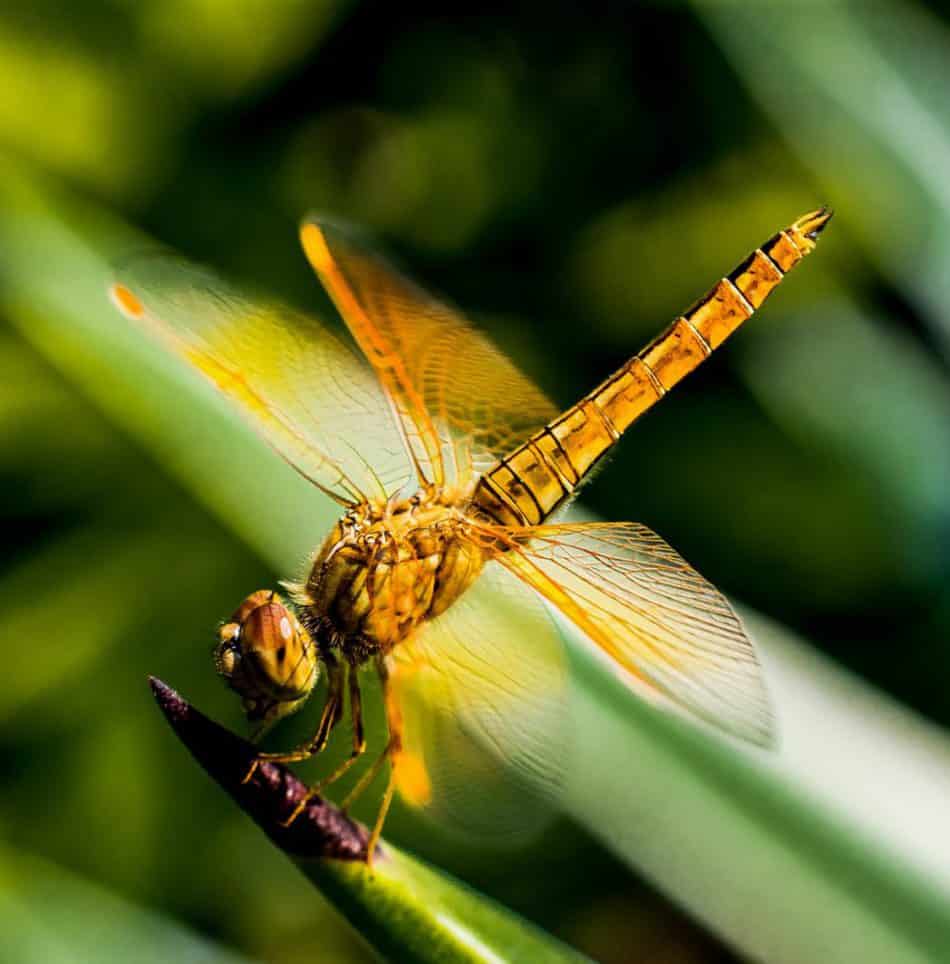
Yellow colors in dragonflies often occur in conjunction with natural pigmentation such as red or black, along with beautiful green or blue iridescence. Yellow is taken to symbolize happiness, optimism, intellect and honor.
a) Are Yellow Dragonflies Rare?
Yellow being a primary pigmentation, its common to find shades of gold and yellow in dragonflies. The Yellow-veined Dragonfly (Sympetrum flaveolum), also known as the Yellow-veined Darter, is gloriously colorful.
The Globe Skimmer (Pantala flavescens), also called the Globe Skimmer or Globe Wanderer, is a wide-ranging yellow dragonfly known for one of the largest insect migrations known to us – an individual will travel over 3,500 miles, while a family or group can travel more than 11,000 miles in a single migration. The Yellow Dragonfly (Libellula needhami) is endemic to the US.
There are a number of species whose males are other colors, but females tend to have brownish or ocher yellow coloration. Examples include the Red-veined Darter, the Banded Pennant and the Elfin Skimmer.
Also, many species of red dragonflies are yellow in color when they are young. As they reach sexual maturation, the redox states of their epidermal ommochrome pigments regulate their transformation in color from yellow or gold to red.
b) How Do You Identify This Type of Dragonfly?
Gold or yellow dragonflies are often distinctive in color. The Yellow-veined Dragonfly is almost impossible to miss, with significant yellow and orange coloration towards the base of its wings, especially the hind ones. The male is red bodied. The Globe Skimmer has a reddish yellow head and a golden yellow torso.
Their wing colors vary from clear to yellowish brown. A species of the Globe Skimmer found on Easter Island has black wings. The female Elim Skimmer (Nannothemis bella) is black and yellow, resembling a wasp.
c) Where Can They Be Found?
Yellow dragonflies are found all over the world. The Yellow-veined Dragonfly is native to Europe, as well as middle and northern China, with occasional migrations into the UK.
The Globe Skimmer is found all over the world except Antarctica, though they are relatively rare in Northern Europe. The Yellow Dragonfly is found in the Eastern US and Canada.
Can Dragonflies Be Orange?
Orange is a natural color, which occurs due to pigmentation and is found both on open and closed wings of dragonflies. It is often difficult to distinguish between shades of yellow, orange and red when comparing the colors of a dragonfly.
a) Are Orange Dragonflies Rare?
Orange dragonflies are quite common. One of the striking varieties native to the US is the Flame Skimmer or Firecracker Skimmer (Libellula saturata). The Globe Skimmer, mentioned above, can be shaded more towards orange or gold, rather than yellow.
Two denizens of the Sonoran Desert that flash bright orange colors are the Red Rock Skimmer (Paltothemis lineatipes) and the Mexican Amberwing (Perithemis intensa). The male Golden-winged Skimmer (libellula auripennis) is mostly orange in color. The Halloween Pennant (Celithenis eponina) is another distinctive species.
b) How Do You Identify This Type of Dragonfly?
Orange is a natural pigmentation, so dragonflies of that color are easy to spot. The entire body of the adult male Flame Skimmer is a fiery, orange, making them stand out. Females tend to be darker, shading towards brown with yellow patches.
The Red Rock Skimmer has a red body, but with orange patches. The male has bright orange wings. The Mexican Amberwing is an even brighter orange, sporting orange shaded wings with white veins and an orangish-brown body. Golden-wing skimmers have an orange body with a dark stripe down the middle and transparent wings with orange edges and veins.
They are close in appearance to Needham Skimmers. The Halloween Pennant looks very like a butterfly, sporting orange-yellow wings with dark brown wings – hence its name.
c) Where Can They Be Found?
Orange dragonflies are found on every continent. Flame Skimmers are common in the American Southwest. The Red Rock Skimmer and Mexican Amberwing are common in the Sonoran Desert in Arizona and California the US and Northern Baja California in Mexico. Golden-range Skimmers are found in the eastern US and Mexico. Halloween Pennants can be found in eastern US and southern Canada.
Can Dragonflies Be Blue?

Blue is a common iridescent color that occurs in dragonflies, sometimes on the body but also often in the wings or eyes.
a) Are Blue Dragonflies Rare?
A common American dragonfly is the Blue Dasher (Pachydiplax longipennis), a dragonfly that belongs to the skimmer family. The Banded Pennant (Celithemis fasciata) has a long bluish abdomen and wings. The Blue-eyed Darner (Rhionaeschna multicolor) is an extremely pretty and colorful specimen generally found in North America.
Two dragonflies found in the British Isles, the Azure Hawker (Aeshan caerulea) and the Common Hawker (Aeshan juncea), are both characterized by long black bodies with distinctive blue markings. The Broad-bodied Chaser or the Broad-bodied Darter (Libellula depressa) is another species where blue stands out distinctly from a brown torso.
One species of the Sapphire Flutterer (the lesser blue wing, Rhyothemis triangularis) is a small blue dragonfly whose wings have metallic blue patches. The male Elfin Skimmer (Nannothemis bella) is powdery blue in color.
b) How Do You Identify This Type of Dragonfly?
Blue dragonflies are easy to identify due to their bright iridescence. The male Blue Dasher has vibrant blue color, yellow-striped thorax and metallic green eyes. The females are drabber in color, yellow and brown with red eyes.
The male Banded Pennant can be recognized by its steely blue abdomen and black tips to its blue wings, the female has a dark abdomen with yellow patches on top of the segments. Blue Dormer males are characterized by chalky blue eyes that are the same color as their abdomen, making them easy to spot. Females do not have blue eyes and sport a yellow-green color in the areas where the male shows blue.
The Azure Hawker and Common Hawker both have distinctive blue marks that stand out on long black bodies. The Common Hawker has a yellow costa on the wings, while the Azure Hawker is smaller, has brown costa on its wings and no yellow marks.
Male Common Hawkers have blue eyes, while females have yellow-green eyes. Broad-bodies Chasers have a distinctively wide abdomen, which is pale blue in contrast with its brown thorax. Unlike the other species of Sapphire Flutterers (the Rhyothemis princeps), the Rhyothemis triangularis tends to show dark blue rather than purple in sunlight.
c) Where Can They Be Found?
Blue dragonflies can be found the world over. The Blue Dasher is widely distributed in North America and into the Bahamas. The Banded Pennant is common all over the Eastern half of North America. Blue-eyed Dormers are found west of the Rocky Mountains, from Canada down to Mexico.
The Azure Hawker is only found in the Scottish Highlands. Broad-bodied Chasers can be found in Southern Europe, Central Asia and the Middle East, and parts of Scotland and Scandinavia. The Sapphire Flutterers are found in eastern and southern Asia.
Can Dragonflies Be Brown?
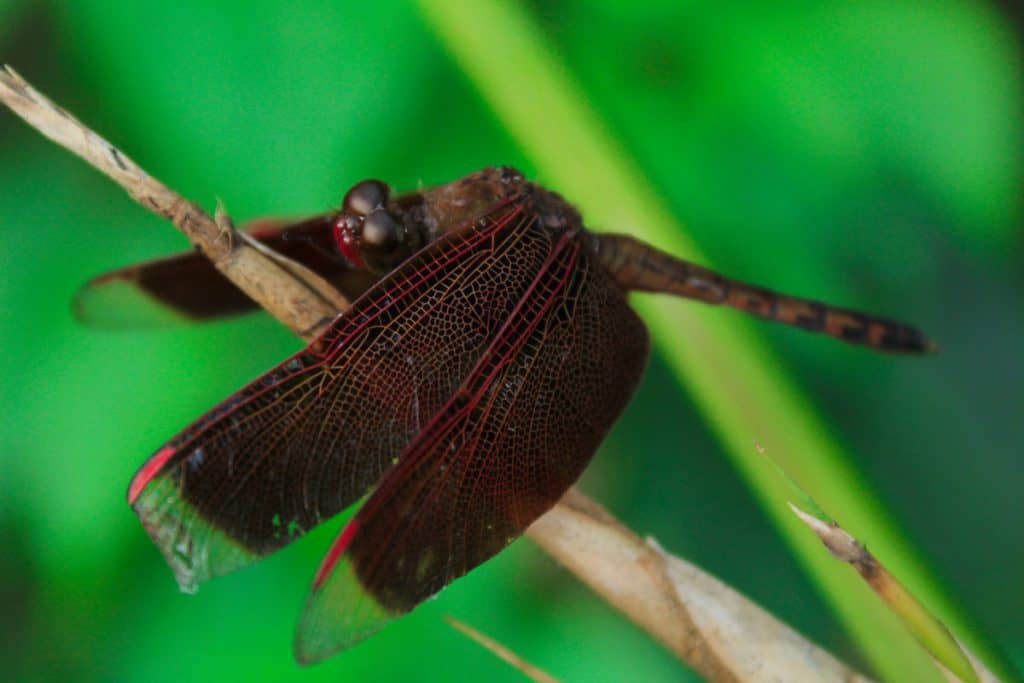
Brown pigmentation is very common in dragonflies, whether in some parts of the wing or as the predominant color. Brown is even commoner in the female of many species.
a) Are Brown Dragonflies Rare?
Brown dragonflies are common. There are two closely related species found in the UK, the Norfolk Hawkers (Aeshna isosceles) and Brown Hawkers (Aeshna grandis). The former was extremely rare to find till recently. These small hawker dragonflies are also found around the Mediterranean Coast of Europe and in Northern Africa.
The Southern or Blue Hawker (Aeshna cyanea) is another species of brown hawker dragonfly. The Common Sanddragon (Progomphus obscuras) is brown, with patches of yellow and black. The Yellow-legged Meadowhawk (Sympetrum vicinum) is a small species found principally in North America.
As mentioned above, the females of many species tend to be brown or yellowish-brown in color – for example, the female Hudsonian Whiteface, Flame Skimmer, Cardinal Meadowhawk, Roseate Skimmer and Blue Dasher.
b) How Do You Identify This Type of Dragonfly?
The Norfolk Hawker are large, gingery-brown with bright green eyes, clear wings and a small yellow triangle on their abdomen. The Brown Hawker looks similar, but with a darker brown coat, blue dots down its side and brown tinted wings. The Southern Hawker is a large dragonfly with a long body.
The thorax is brown, with two wide green stripes and a black spot in the shape of the letter “T” on the forehead. The Common Sanddragon has a brown abdomen, with yellow markings of the tip. They can be found near running water. The Yellow-Legged Meadowhawk has a brown torso as an adult but can be distinguished by the yellow legs.
c) Where Can They Be Found?
Brown dragonflies can be found in every continent. The Norfolk Hawker and Brown Hawkers are native to the UK. The species can also be found in Southern Europe and Northern Africa. Southern Hawkers are found predominantly in the UK. The Common Sanddragon is found East of the Rockies in the US and Canada. The Yellow-legged Meadowhawk can be found in three broad belts across the US and Canada.
Can Dragonflies Be Purple?
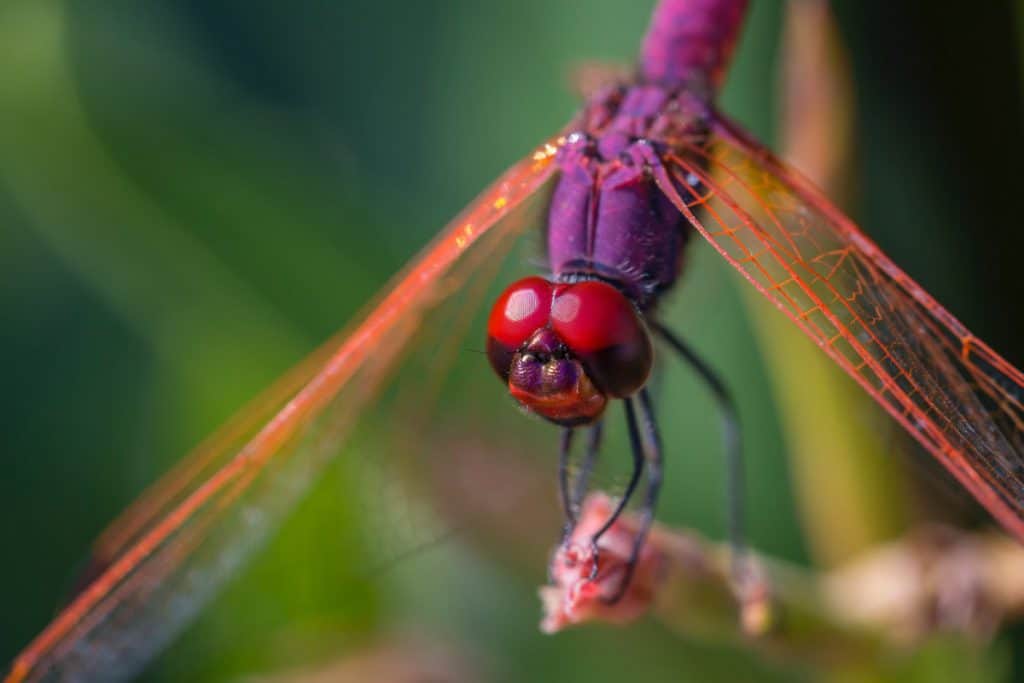
Purple is a shiny, iridescent color, and as such, may tend towards scarlet in dragonflies.
a) Are Purple Dragonflies Rare?
Purple dragonflies are not exactly rare. However, you do not always find a consistently purple color. Its more common to find various shades of blue, black and purple co-mingled on a dragonfly’s wings. One example is the Scarlet Dragonfly (Crocothemis erythreaea), also known as the Common Scarlet-darter or Broad Scarlet dragonfly. The male Cardinal Meadowhawk (Sympetrum illotum) is bright scarlet in color, though females tend to be reddish-brown.
A truly purple species is the Purple Skimmer (Libellula jesseana), a Florida native. The Common Marsh Glider (Trithemis aurora) is another reddish-brown dragonfly that can tend towards either pink or purple shades. The Scarlet Dwarf (Nannophya pygmaea), also known as the Northern Pygmyfly or the Tiny Dragonfly, is native to Asia. The Sapphire Flutterer (Rhyothemis princeps) is a blue-black butterfly that flashes bright purple iridescenc
b) How Do You Identify This Type of Dragonfly?
Purple dragonflies may be difficult to differentiate from the many shades of scarlet, blue and black butterflies. The Scarlet Dragonfly has a bright scarlet red abdomen with small amber patches at the bases of its hindwings. The Purple Skimmer has a metallic bluish-purple thorax and abdomen, with orange wings. The female can be similar or have a golden hue similar to the Golden-winged Skimmer.
The Common Marsh Glider male has a crimson abdomen and thorax, with a purple shade tending towards violet. The face is reddish-brown. The female, on the other hand, has an olive colored thorax with brown and black stripes. The thorax is reddish-brown. The Sapphire Flutterer has a dark blue body and wings, but its color can show as an iridescent metallic purple as it flutters in the sunrise.
c) Where Can They Be Found?
Purple dragonflies can be found on every continent. The Scarlet Dragonfly ranges from Southern Europe to Africa and parts of West Asia all the way to Southern China. The Purple Skimmer is endemic to Florida. The Common Marsh Glider is abundant over Southeast Asia and the Indian Subcontinent. The Scarlet Dwarf is found in Southeast Asia (including China and Japan), stretching to Australia. The Sapphire Flutterer can only be found on Australia and New Guinea.
Can Dragonflies Be Green?
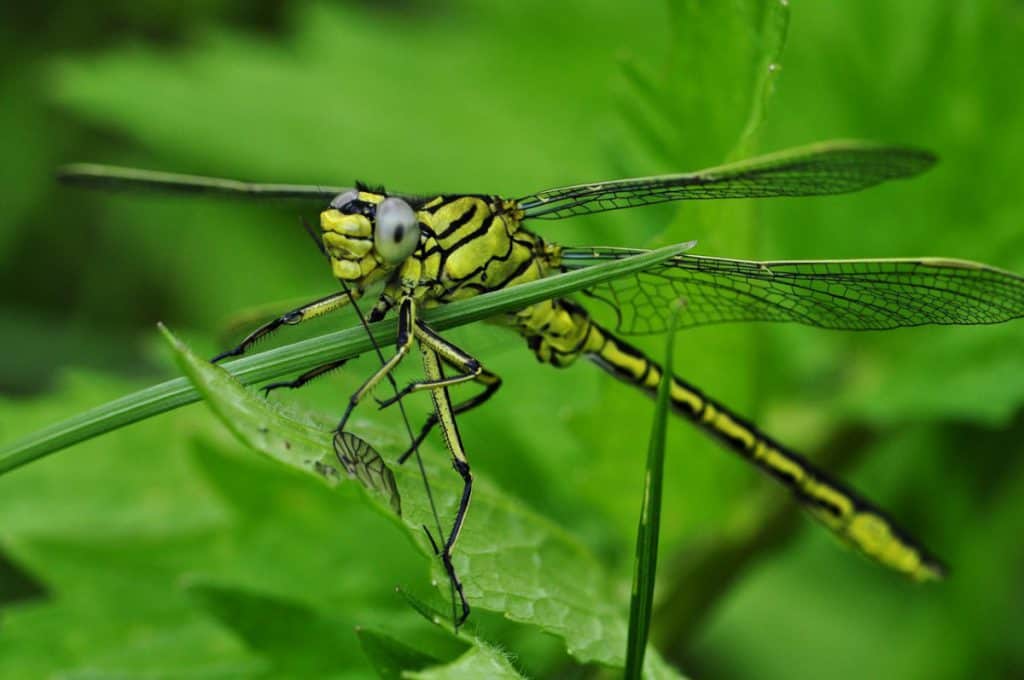
Green is one of the iridescent colors that flashes on the simmering wings of a dragonfly. The effect is usually produced due to a blue iridescence on dragonflies with a yellow pigment.
a) Are Green Dragonflies Rare?
Green dragonflies are common. The largest, and fastest, dragonfly in the US is the Giant Hawaiian Dragonfly or Pinao (Anax Strenuus), which is pale green in color. The Common Green Dorner (Anax junius) is another large species found in North America. The Emperor Dragonfly (Anax imperator) is similar in size, but mostly found in Europe, Africa, Asia and the Middle East. The male Western Pondhawk (Erthemis collocata) is emerald green in color when young, but becomes an ashy, powdery grey as they age.
One of the rarest dragonflies in the world is the Hine’s Emerald Dragonfly, the only dragonfly on the US Federal Endangered Species list.
b) How Do You Identify This Type of Dragonfly?
Typically, green dragonflies have very distinctive markings, which make them easy to identify. The Giant Hawaiian Dragonfly is around 5 and a half inches in span, and thus distinctive. The males have blue markings on their pale green sheen. The Common Green Dorner can be large and can typically be identified by its bright green colors.
The male has an eyespot on the head, giving it a cyclops like appearance. In adult Emperor Dragonflies, the male has an apple green thorax and head, along with a sky-blue abdomen with a black dorsal stripe. The female Emperors are mostly green though with similar markings. The Western Pondhawk is found near shallow ponds and have an emerald green torso with black markings.
The Hine’s Emerald Butterfly can be recognized by its bright green emerald eyes, contrasting with its metallic body with yellow stripes on the side.
c) Where Can They Be Found?
Green dragonflies are common all over the world. The Giant Hawaiian Dragonfly is native only to Hawaii. Common Green Dormers are found all over the US and Canada. The Emperor Dragonfly is found throughout Africa and Europe, the Arabian Peninsula and south=western and central Asia. The Hine’s Emerald Butterfly is only found in Door County, Wisconsin. Less than 15,000 are estimated to remain. The Western Pondhawk can be found all over the western parts of the US.
Can Dragonflies Be Grey?
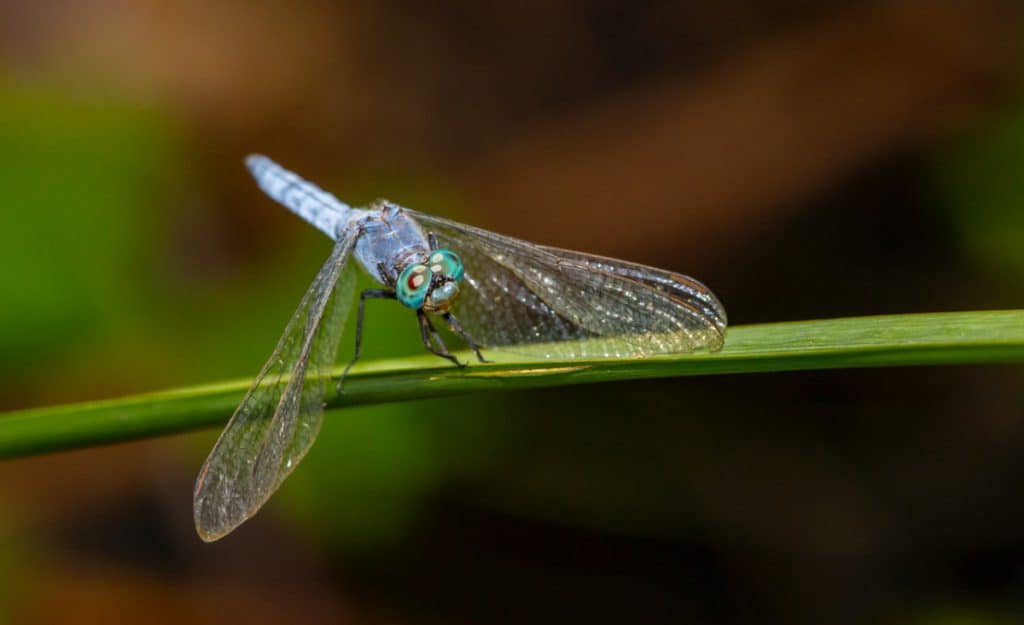
There are thousands of species of grey, white or zebra colored dragonflies. Often times, grey is combined with some other bright, iridescent color.
a) Are Grey Dragonflies Rare?
Grey dragonflies abound all around the world. Many dragonflies are grey or brown when young, a coloration that helps protect them from predators. Some common species include the Grey Sand Dragon (Progomphus borealis), which are common along streams in the foothills of mountains in the Upper Sonoran Desert. The Filigree skimmer (Pseudoleon superbus) is found all over the Southwestern US. The Eight Spotted Skimmer (Libellula forensia) is a briliiantly marked skimmer dragonfly found in the western US.
b) How Do You Identify This Type of Dragonfly?
Grey dragonflies are often hard to spot due to their dirty white sheen. For example, the Grey Sand Dragon is well camouflaged in the gray landscape of the Sonoran Desert. It can be distinguished by the last few segments of its tail being enlarged, giving it a club like appearance.
The Filigree Skimmer is typically found close to stream beds – its grayish black body and transparent wings with black patches stand out against light gray or green surfaces. The Eight Spotted Skimmer has distinctive white bands on its wings and on parts of its gray body – the female of this species is the only one found in the US with white spots on their wings.
c) Where Can They Be Found?
Grey dragonflies can be found on every continent. The Grey Sand Dragon is common in the Sonoran Desert. The Filigree Skimmer is found in Texas, Arizona, New Mexico and California, as well as Northern Mexico. The Eight Spotted Skimmer is found all over the territory west of the Rocky Mountains in the US.
Can Dragonflies Be Pink?
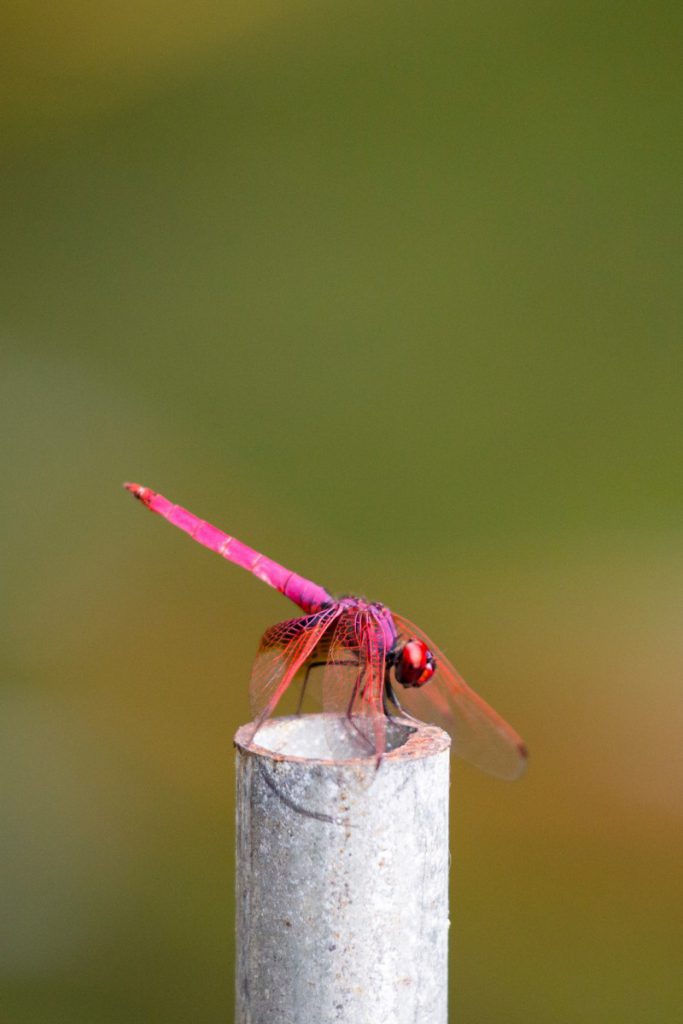
Pink is not a color that exists in nature, it is not a wavelength or particle, and does not appear in the visible spectrum. Often times, our brain perceives something to be pink, without the color actually being present. Having said that, there are definitely some pink dragonflies around.
a) Are Pink Dragonflies Rare?
Pink dragonflies are rare – most dragonflies that are close to pink appear more red or reddish-brown in color. Out of the 400+ species found in the US, less than a dozen project a true pink color. A few species do exist. The Roseate Skimmer (Orthemis ferruginea) is one – especially the males which have a lipstick-red abdomen that seems to pulsate like a light tube. The Common Marsh Glider (Trithemis aurora) is another reddish-brown dragonfly that can tend towards either pink or purple shades.
b) How Do You Identify This Type of Dragonfly?
The Roseate Skimmer male adult has a distinctive rose pink and red abdomen, the wings have brown tips. The females have an orange-brown abdomen. The Common Marsh Glider has been described previously, the males have more of a pinkish-purple shade.
c) Where Can They Be Found?
Roseate Skimmers are abundant in the Americas, in a belt from the US down to Brazil. The Common Marsh Glider is found in South and South East Asia.
In Conclusion …
Dragonflies are among the most beautiful creatures on Planet Earth. Unfortunately, their numbers are dwindling due to habitat loss, hunting by collectors, encroachment of other invasive species and effects of pesticides. Conservation efforts are underway in many countries, but we all must do our parts to ensure that we chip in.
The next time there is a chance to save a rare breed, get educated on how you can help. The presence of such beauty graces us all – let’s not ignore them into extinction.
If you enjoyed reading this article, then please share it out on social media. It helps promote the site and keeps me motivated to produce the best articles I can.
All the best
Steve
ps If you’re interested in reading more about the color of insects, why not check out our Color Of Ladybugs article or Color Of Butterflies articles or The Color Of Spiders Article
Recent Posts
Tiny Black Bugs in Bathroom NO WINGS: What They Are and What to Do!
Finding tiny black bugs in your bathroom can be uncomfortable, to say the least. Especially if they are persistent, or they appear in very large numbers, which they often like to do. When it...
Tiny Black Bugs in Plant Soil - What Are They & What To Do About It
A short horror story: You get a new houseplant. You do your best to take care of it. You’ve ensured that it has the right soil, the right amount of sun, it gets enough water. And then one day, you...

